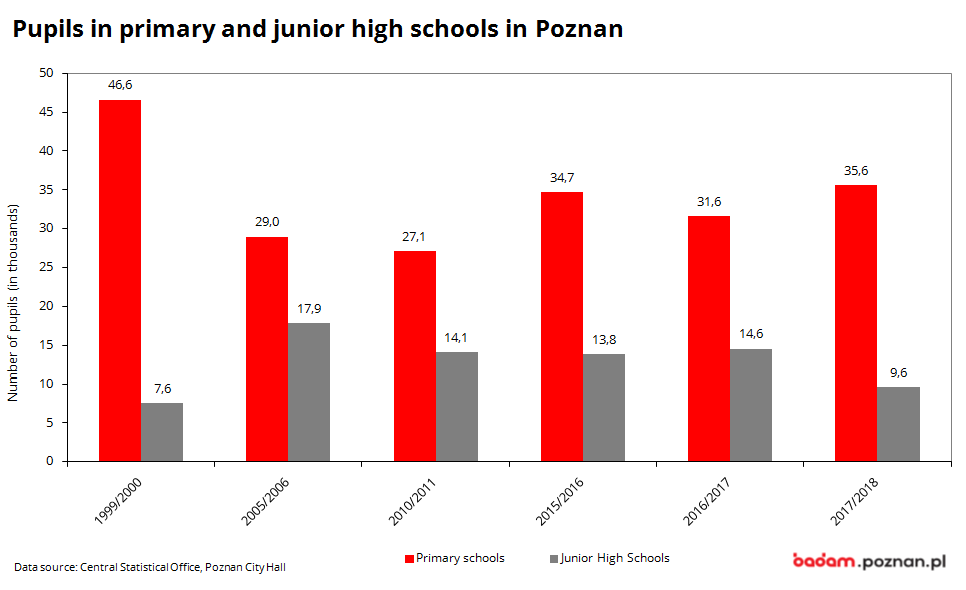Poznań City Hall’s archive, photo D. Tryba
The 2016/2017 school year was the last year before the introduction of the educational reform.
Primary and middle schools
In the 2016/2017 school year, in Poznań there were:
- 116 primary schools in which a total of 32.3 thousand pupils were learning in the six-grade system. During the year, there was a drop in the number of pupils by 2.4 thousand. The majority of primary schools were run by the City of Poznań (84);
- 86 middle schools in which 14.1 thousand pupils were studying. Most of these facilities were run by the City of Poznań (57);
- 6 special primary and middle schools for pupils with special educational needs due to their health condition or disability. They were attended by 1 thousand pupils.
School facilities with bilingual units, including 17 schools and 5 middle-school classes with: English, Spanish, German and Russian, attended by over 1 thousand pupils, were functioning in Poznań.
In the 2016/2017 school year, places in the 1st and 2nd degree art schools were prepared for artistic talents in 4 schools. They were attended by approx. 1 thousand pupils.
Upper-secondary schools
Upper secondary educational system in Poznań included 87 high schools, vocational secondary schools and vocational schools, as well as art schools. They were attended by a total of 22.7 thousand pupils. Just over half of pupils were learning in high schools. Vocational secondary schools are also becoming more and more popular.
Post-secondary schools enjoyed great interest in Poznań. An offer of 65 facilities was prepared for their student, and taken up by over 9.7 thousand people.
34 upper-secondary schools for adults were educating 4.9 thousand people. The greatest number of people was studying in high schools.
Development of vocational education
The City of Poznań systematically undertakes measures aimed at encouraging people to acquire a profession in industry schools. Projects implemented in 2017 included:
- “Professional qualifications as the key to success – support for development of vocational education in the Municipal Functional Space of Poznań”, for which EU funding was granted in the amount of PLN 8.7 million as part of the ITI. Participants of the project are industry schools whose students can take advantage of new opportunities to acquire professional qualifications, internships at employers and better conditions of education in well-equipped laboratories.
- “Respect for Professionals” – campaign under which the next “Arena of Professions” educational fair was organised. During the fair, vocational secondary schools and industry schools from Poznań presented their offer.
Base of care for students from outside of Poznań
In 2017, 4.6 thousand students from outside of Poznań used 10 public and school dormitories and youth hostels with 882 beds, including 2 facilities for people with disabilities.
Educational projects for newcomers
In 2017, the City of Poznań implemented a governmental programme for the integration of the Roma community (among others, in primary schools No. 4, 66 and 70) and supporting pupils of Roma origin. Further positions of Roma education assistants were opened in schools where children of Romani origin are learning, and school kits were subsidised.
390 pupils – foreigners were learning in public educational facilities, including 250 children attending primary schools and pre-school units at primary schools, with the opportunity to take additional Polish lessons. In 2017, the largest group of such pupils were people from Ukraine.
Number of primary school pupils in Poznań
| 2010 | 2014 | 2015 | 2016 | 2017 | 2017/2010 w % | |
| Primary school pupils (in thousands) | 27,8 | 31,8 | 34,7 | 32,3 | 35,6 | 128,0 |
Source: Polish Central Statistical Office
Number of primary school pupilss in the largest Polish cities (2016)
| Poznań | Kraków | Łódź | Warsaw | Wrocław | |
| Primary school pupils (in thousands) | 32,3 | 41,3 | 35,1 | 108 | 33,5 |


